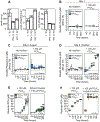Redox-active antibiotics enhance phosphorus bioavailability
- PMID: 33674490
- PMCID: PMC8051141
- DOI: 10.1126/science.abd1515
Redox-active antibiotics enhance phosphorus bioavailability
Abstract
Microbial production of antibiotics is common, but our understanding of their roles in the environment is limited. In this study, we explore long-standing observations that microbes increase the production of redox-active antibiotics under phosphorus limitation. The availability of phosphorus, a nutrient required by all life on Earth and essential for agriculture, can be controlled by adsorption to and release from iron minerals by means of redox cycling. Using phenazine antibiotic production by pseudomonads as a case study, we show that phenazines are regulated by phosphorus, solubilize phosphorus through reductive dissolution of iron oxides in the lab and field, and increase phosphorus-limited microbial growth. Phenazines are just one of many examples of phosphorus-regulated antibiotics. Our work suggests a widespread but previously unappreciated role for redox-active antibiotics in phosphorus acquisition and cycling.
Copyright © 2021 The Authors, some rights reserved; exclusive licensee American Association for the Advancement of Science. No claim to original U.S. Government Works.
Conflict of interest statement
Figures




Similar articles
-
Phenazines and other redox-active antibiotics promote microbial mineral reduction.Appl Environ Microbiol. 2004 Feb;70(2):921-8. doi: 10.1128/AEM.70.2.921-928.2004. Appl Environ Microbiol. 2004. PMID: 14766572 Free PMC article.
-
Rethinking 'secondary' metabolism: physiological roles for phenazine antibiotics.Nat Chem Biol. 2006 Feb;2(2):71-8. doi: 10.1038/nchembio764. Nat Chem Biol. 2006. PMID: 16421586 Review.
-
Nitrate Reduction Stimulates and Is Stimulated by Phenazine-1-Carboxylic Acid Oxidation by Citrobacter portucalensis MBL.mBio. 2021 Aug 31;12(4):e0226521. doi: 10.1128/mBio.02265-21. Epub 2021 Aug 31. mBio. 2021. PMID: 34465028 Free PMC article.
-
Pseudomonas aeruginosa PumA acts on an endogenous phenazine to promote self-resistance.Microbiology (Reading). 2018 May;164(5):790-800. doi: 10.1099/mic.0.000657. Epub 2018 Apr 9. Microbiology (Reading). 2018. PMID: 29629858 Free PMC article.
-
Phenazines in plant-beneficial Pseudomonas spp.: biosynthesis, regulation, function and genomics.Environ Microbiol. 2018 Nov;20(11):3905-3917. doi: 10.1111/1462-2920.14395. Epub 2018 Oct 15. Environ Microbiol. 2018. PMID: 30159978 Review.
Cited by
-
Choreographing root architecture and rhizosphere interactions through synthetic biology.Nat Commun. 2024 Feb 14;15(1):1370. doi: 10.1038/s41467-024-45272-5. Nat Commun. 2024. PMID: 38355570 Free PMC article. Review.
-
Metagenomic Insight into The Global Dissemination of The Antibiotic Resistome.Adv Sci (Weinh). 2023 Nov;10(33):e2303925. doi: 10.1002/advs.202303925. Epub 2023 Oct 23. Adv Sci (Weinh). 2023. PMID: 37870180 Free PMC article.
-
Unraveling iron oxides as abiotic catalysts of organic phosphorus recycling in soil and sediment matrices.Nat Commun. 2024 Jul 18;15(1):5930. doi: 10.1038/s41467-024-47931-z. Nat Commun. 2024. PMID: 39025840 Free PMC article.
-
Bacterial biofilms as an essential component of rhizosphere plant-microbe interactions.Methods Microbiol. 2023;53:3-48. doi: 10.1016/bs.mim.2023.05.006. Epub 2023 Jun 22. Methods Microbiol. 2023. PMID: 38415193 Free PMC article. No abstract available.
-
Diverse secondary metabolites are expressed in particle-associated and free-living microorganisms of the permanently anoxic Cariaco Basin.Nat Commun. 2023 Feb 6;14(1):656. doi: 10.1038/s41467-023-36026-w. Nat Commun. 2023. PMID: 36746960 Free PMC article.
References
-
- Davies J, Ryan KS, Introducing the parvome: bioactive compounds in the microbial world. ACS chemical biology 7, 252–259 (2012). - PubMed
-
- Demain AL, Fang A, in History of Modern Biotechnology, Fietcher A, Ed. (Springer-Verlag, Berlin, Heidelberg, 2000), pp. 1–39.
-
- Price-Whelan A, Dietrich LEP, Newman DK, Rethinking ‘secondary’ metabolism: physiological roles for phenazine antibiotics. Nature Chemical Biology 2, 71–78 (2006). - PubMed
-
- Whooley MA, McLoughlin AJ, The regulation of pyocyanin production in Pseudomonas aeruginosa. European Journal of Applied Biotechnology, 1–8 (1982).
-
- Martín JF, in Advances in Biochemical Engineering, Ghose T, Fietcher A, Blakebrough N, Eds. (Springer, Berlin, Heidelberg, 1977), vol. 6, pp. 105–127.
Publication types
MeSH terms
Substances
Grants and funding
LinkOut - more resources
Full Text Sources
Other Literature Sources
Medical
Miscellaneous

